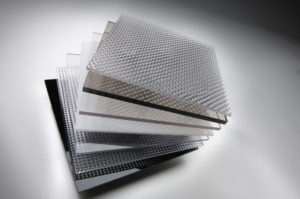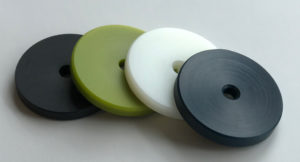Plastics are becoming the go-to material for an array of industries, replacing common materials such as metal, glass, ceramics, wood, etc. Their strength paired with lower weight make them a safer, more reliable alternative in many industries. However, with literally hundreds of types and grades available, determining which one is best for you can be a daunting endeavor.
Polymershapes experts work with your industry experts or project managers to select the right plastic material for your specific application. Our process includes a rigorous selection process that is designed to zero in on which materials directly fit the needs and requirements for your application and industry.
Step 1: The Primary Function of Your Part
To select the best material for your application, our plastics experts will work with the leaders in your field to understand the key elements of your application. Insights from your industry experts will help our professionals determine which type of plastic best suits your needs.
Structural Parts
Many applications involve the material being the core component of a larger structural unit, making the long-term qualities of the material extremely important. Structural materials need to be able to endure immense amounts of stress over a sustained period of time. The right material can provide months, years, or even decades of reliability while under constant pressure. Understanding what kinds of stress, weight, and pressure the structure may encounter will help ensure the material that gets selected promotes structural integrity. Structural materials often include PEEK, ULTEM® polyetherimide, UHMW, and Glass-filled plastic options.
Weight-Bearing or Wear Parts
Many industries utilize heavy machinery with parts that endure elevated temperatures and velocities. Over time, many parts could deform, degrade, or wear away due to the stress. The right material will be impact and wear resistant. Many plastics such as acetal (polyoxymethylene, POM), nylon (Polyamide, PA), or UHMW have the physical properties needed to handle harsh temperatures, bear prolonged weight and stress, and endure constant contact with other parts without wear.
Clear Lenses/Transparent Parts
There are certain applications that require high optical clarity. Whether it’s lenses or clear machine guards, optical transparency may play a key role in effective operation. While glass could suffice, it may not meet strength and safety requirements. Plastic materials such as acrylic (Polymethyl methacrylate, PMMA) or SABIC’s LEXAN™ polycarbonate (PC) have similar optical properties to glass, with up to 200 times the impact strength and shatter resistance.
Plastic Containers
Many industries and sectors, such as the healthcare sector and food/beverage industry, rely on plastics for various containers. Many containers need impact resistance to protect the contents, but may also require chemical resistance or anti-leeching properties. There are various plastic options available that can be used as containers, many of which include FDA or USDA-compliant options. Among the most common are polypropylene (PP), high-density polyethylene (HDPE), polyvinyl chloride (PVC), polyethylene terephthalate (PET), etc.
What are you not getting with your current material?
To make sure we select the best material, we get started by asking why you need a different material in the first place. By looking at what you’re currently using, and what qualities you aren’t getting from it, we can tailor our selection process to address your specific needs.
Step 2: Mechanical Properties
Mechanical strength can be quantified in many different ways, and each may vary in importance depending on your needs. Each plastic material option undergoes rigorous testing to not only ensure compliance, but also determine which applications it may be best suited for. Some of the most common and important mechanical properties include:
- Tensile Strength: Measures a material’s resistance to being pulled apart. High tensile strength allows a plastic sheet to retain its shape and resist deformation when being stretched or pulled.
- Flexural Modulus: Measures a material’s bending resistance. Certain mechanical or weight-bearing applications require a material that can retain its shape and strength after being bent.
- Izod impact: Measures a material’s toughness. Izod impact rating is an ASTM standard determined by slamming the material repeatedly on either side. The rating is measured by how much force is required to fracture the material.
Plastics are an incredibly common alternative to metals, ceramics, and other materials. Hundreds of options are available, and investigating the mechanical needs of your application will help narrow down which options are best for you.
For Weight-Bearing/Wear Applications
There are many different ways to measure the strength and capabilities of plastic materials. The different forms of strength also vary in importance depending on the demands of your application. Some applications require the material to sustain certain pressure levels over an extended period of time. Others may need a material that can retain its strength while holding certain weight levels. Other applications may involve movement and rapid changes of direction. These applications are more demanding and require further discretion during the selection process.
Pressure and/or Velocity
Velocity is often a major factor that dictates which materials are needed to maximize reliability. High-velocity applications are often accompanied by all sorts of other demands that require high-performance materials. Velocity is often accompanied by pressure, which together dictate how much wear and tear the material will experience, and what level of strength is needed for optimal reliability. Data and insights that indicate the pressure and velocity demands will help determine which plastic would suit that function best.
Intermittent or Continuous Motion
The type of motion involved can have a major impact on which material is the best solution. Intermittent motion with a lot of starting and stopping can generate rapidly fluctuating conditions. This could lead to radical variance in temperatures, pressures, etc. Plastic options that fit these applications ideally have a low coefficients of friction and thermal linear expansion.
Continuous motion may have a more stable operating environment, but generally remain in exceedingly high temperatures and pressures for extended periods of time. Materials with high continuous operating temperatures are usually required to meet these needs.
Step 3: Operating Temperature Properties
One of the most important factors in determining which material you need is operating temperature. Many applications generate conditions well above room temperature. Each individual plastic has their own unique temperature tolerances, which makes the specific needs of your application an integral part of the selection process.
Maximum/Minimum Service Temperatures
The operating temperature range measures the maximum (and sometimes minimum) temperature a material can endure before desired qualities begin to drop off. The temperature demands of your application depend on the regular operating environment as well as extreme conditions. It’s important that the material selected can endure continuous exposure to operating conditions. Selecting the right material will ensure reliable performance and avoid product failure.
Dimensional Stability
Many applications, especially those that require tight tolerances, require materials that can retain their size and shape across a wide array of operating conditions. Dimensionally stable plastics such as acetal, PEEK, ULTEM™ polyetherimide, and PET are known for not warping, shrinking, or bending while under extreme conditions. They can be heated, cooled, and reheated while remaining the same shape, size, and dimensions.
Melting Point
The melting point is the maximum temperature a plastic can endure before a solid plastic degrades into a viscous state. Long-term exposure to this temperature will cause a breakdown in molecular structure, resulting in deformation until it transitions from a solid into a liquid.
High-Performance/Imidized Plastics
While many plastics have a wide temperature range, certain industrial or engineering applications work with temperatures that extend far beyond common options. At the very top of the plastics pyramid are imidized plastics, which undergo a rigorous curing process to expand their operating temperature. Imidized materials such as polybenzimidazole (PBI) or polyamide-imide (PAI) can handle temperatures of up to 500°F (260°C).
Step 4: Chemical/Electrical Exposure, and Other Needs
Many industrial applications operate around or handle dangerous elements that need to be controlled or protected.
Chemical
Certain plastics are better equipped to interact with acids, bases, solvents, and chemical solutions than others. Many plastics have risen in popularity as an alternative to metal due to their corrosion resistance and low absorption. Our selection process includes getting insights from your experts regarding the chemicals the application will interact with. Different types of plastic have varying levels of tolerances, so looking into the pH levels of every chemical will help refine the selection process. Chemically resistant plastics, such as PVC, PEEK, or PTFE, are known for their ability to handle prolonged exposure to strong acids without dissolving or sustaining damage.
This step also includes evaluating the use of hot water/steam, chlorine, cleaning solutions, and more. Isolating which chemicals you work with is a major step in eliminating which materials aren’t appropriate for your application and helps us narrow in on which specifically ones are.
Electrical
Electrical applications require a material that can handle prolonged exposure to heat and electrical charges. Other important qualities in hydrolytic stability, static dissipative qualities, and perhaps piezo/pyroelectricity in certain applications. Plastics like acrylonitrile butadiene styrene (ABS), polyvinyl chloride (PVC), or polyamide-imide (PAI) are commonly found in the electrical industry due to their various properties.
Step 5: Regulatory Compliances
Many sectors, such as the healthcare industry, food and beverage industry, chemical processing, etc. have many strict regulations and guidelines they have to adhere to. Compliance often requires highly specialized materials, and although there are thousands of plastic options available, only a few may be compliant.
The American food and beverage industry looks to the FDA, USDA, NSF, and 3A for guidelines and regulations. Common requirements for compliance include inertness to certain acids, bases, or solvents, anti-leeching properties, low/non-BPA materials, etc. Food grade plastics are also commonly blue in color, making them visually detectable.
Medical grade plastics often need FDA, USP, BPOG, or ISO compliance to be used in the field. Most of these regulations look into a material’s biocompatibility, behavior around hazardous substances, reactive behaviors, etc. Such compliance makes them great options for machine parts, medical devices, etc.
Keeping in mind what regulations your material needs to satisfy, we can make an informed decision over which product is the most compliant option for your specific application.
Step 6: Final Selection
Polymershapes’ distribution centers have an in-depth material selection process to ensure your new material has the qualities it needs. Every step in the process entails in-depth collaboration with your industry experts to ensure long-sting performance and safety.
Polymershapes has a wide variety of plastic options for use across various industries. Whether your application demands high impact resistance, electrical properties, chemical resistance, or others, our inventory has solutions from the world’s most reputable brands. To learn more about our selection process and which material options we have available, reach out to a Polymershapes plastic distribution center near you.



